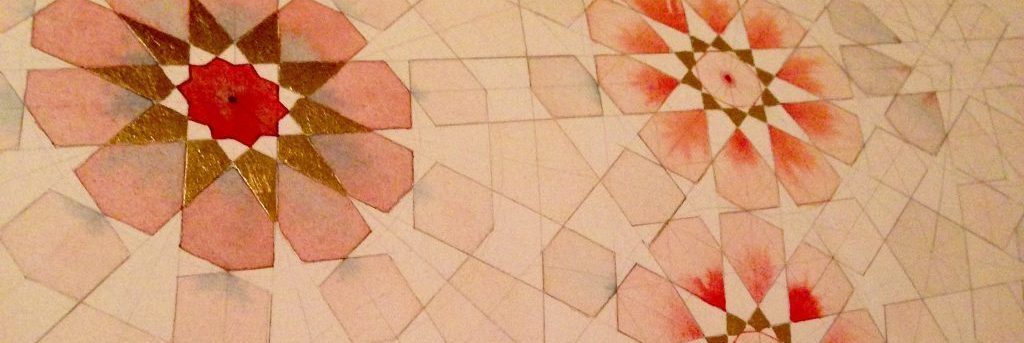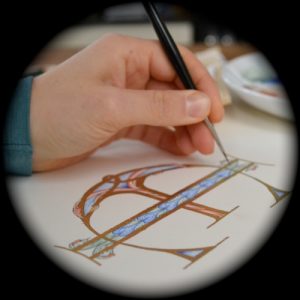We interview a new Second Spring House Artist

We have been recruiting a team of house artists here at Second Spring, to bring another dimension to our online offerings, and to showcase works of art that we think our readers will enjoy. We interviewed one of our new artists, who creates bespoke, hand painted and gilded designs under the name “Pagina Aurata“.
What are some of your artistic influences?
Illuminated manuscripts have had a huge impact on my work. I was entranced by their richness and intricacy when I first studied them from an Art Historical perspective in 2010. Each manuscript is like a treasure chest containing hundreds of openings, each with its own bejewelled offering. They inspire me in many ways, from the way the illuminations guide your reading of the text, to the delicate craftsmanship, and such colour combinations as pale pink and lapis, or earth red, yellow ochre and malachite. With illuminated manuscripts you can spend hours exploring one simple theme, like cities or wings or light.
What else inspires your work, and drives you to make art?
I’m very inspired by traditional crafts and love learning new techniques. I can’t look at great craftsmanship without getting fidgety! Whenever I go to a gallery or a museum, even a market, I have to factor in time afterwards to try out new ideas. I’m also interested in concepts like liminality and boundaries. For instance, I like to see how far I can dilute my paint before it loses impact, or how similar I can make two colours before they become one and the same. I suspect I’m drawn to these ideas because they help me explore my relationship with God.
What techniques do you use, and how did you develop them?
I use handmade pigments and fine brushes, usually mixing egg tempera paint for work on vellum and watercolour when working on paper. I often gild my work as well, using either gold leaf or shell gold depending on the design. I first learnt these techniques at the Prince’s School of Traditional Arts and have since been on a number of courses to explore them further.
When you’re feeling low on creativity, what do you do?
I find exploring new places often refreshes creativity; a new garden, forest or city, even a new season. I often find creativity is restored after a spell outdoors. I also find watching other artists at work and talking to artists a great stimulant for creativity.
Have you read anything interesting recently?
I’ve been reading C.S. Lewis’ Surprised by Joy, though it’s taking me a while as I keep wanting to revisit the first chapter where he recounts his earliest memories of story writing, and the world of happiness it brought him. He wrote from his imagination but, in the case of his stories of Animal-Land it was not, he explains, an imagination of day-dreams and fantasies, but rather of Invention. He wasn’t a character within the story, but rather it’s creator.
Do you have any favourite galleries or museums in England?
There are so many great ones! But I think my favourite has to be the V&A. I love the value it places on design and craftsmanship, and the collection is so varied there’s something for every mood.
Is there anywhere you yearn to travel to at the moment?
I’ve recently returned from an incredible trip to Japan, somewhere I had longed to visit ever since I got obsessed with origami over a decade ago. My husband and I tried a bit of sumi-e painting in preparation for the trip and followed it up with a calligraphy course in Kyoto, both wonderfully meditative practices that encourage alignment of mind, body and spirit whilst painting. Preparation of materials is a ritual in itself and an important part of the meditative process, culminating in grinding the ink stick: a gentle figure of eight motion repeated until the ink reaches the right consistency. The ink preparation encourages an attitude of calm, a still breath and focused mind, all of which are then carried over into the strokes of your painting. I found much affinity with the Medieval illumination tradition and was inspired to refresh my own practice with renewed contemplation; the tradition really lends itself to it—the repetitive grinding and preparing of the pigments, using breath to apply the gold, maintaining a regular breath to keep the hand steady.
Why do you think art matters?
For me personally it matters because it enables me to engage; through it I can access my imagination, make new discoveries, respond to events and places. When travelling in Japan it was certainly my experience of the traditional ink painting and calligraphy that enabled me to understand the culture’s subtle forms of communication, the importance of ritual, as well as their deep and poetic affinity with nature.
What do you think the role of the artist is in the world?
I think Cennini had a point when he said that painting calls on the imagination and skill of hand to discover things not seen. For me, artists present a view of reality that enables us to experience and think about it in a new way.

Red Gibbons-Lejeune is based in the south of England, and trained at the Prince’s School of Traditional Arts.
You can read about all of our House Artists on the Featured Artists page. You may also enjoy Rose-Marie Caldecott’s piece for Second Spring Current on her artistic practice.

